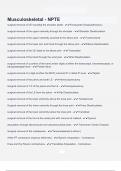STUVIA 2024/2025
Musculoskeletal - NPTE
surgical removal of UE including the shoulder girdle - ✔✔Forequarter (Scapulothoracic)
surgical removal of the upper extremity through the shoulder - ✔✔Shoulder Disarticulation
surgical removal of the upper extremity proximal to the elbow joint - ✔✔Transhumeral
surgical removal of the lower arm and hand through the elbow joint - ✔✔Elbow Disarticulation
surgical removal of the UE distal to the elbow joint - ✔✔Transradial
surgical removal of the hand through the wrist joint - ✔✔Wrist Disarticulation
surgical removal of a portion of the hand and/or digits at either the transcarpal, transmetacarpal, or
transphalangeal level - ✔✔Partial Hand
surgical removal of a digit at either the MCP, proximal IP or distal IP level - ✔✔Digital
surgical removal of the pelvis and both LE - ✔✔Hemicorporectomy
%
Surgical removal of 1/2 of the pelvis and the LE - ✔✔Hemipelvectomy
surgical removal of the LE from the pelvis - ✔✔Hip Disarticulation
surgical removal of the lower extremity above the knee joint - ✔✔Transfemoral
Surgical removal of the lower extremity through the knee joint - ✔✔Knee Disarticulation
surgical removal of the lower extremity below the knee joint - ✔✔Transtibial
surgical removal of the foot at the ankle joint with removal of malleoli - ✔✔Syme's
amputation through talonavicular and calcaneocuboid joints - ✔✔Transverse Tarsal (Chopart)
Surgical removal of the metatarsals - ✔✔Tarsometatarsal (Lisfranc)
Ankle PF contracture (equinus deformity) - ✔✔Syme's Amputation - Contracture
Knee and Hip Flexion contractures - ✔✔Transtibial Amputation - Contracture
stuvia
, STUVIA 2024/2025
Hip Flexion and Abduction contracture - ✔✔Transfemoral Amputation - Contracture
Prosthetic Cause:
Prosthesis too short
Improperly shaped lateral wall
High medial wall
Prosthesis aligned in ABD
Amputee Cause:
Poor Balance
ABD contracture
Improper training
Short Residual Limb
Weak ABD on prosthetic side
Hypertensive and painful residual limb - ✔✔Lateral Bending
Prosthetic:
Prosthetic too long
High Medial wall
%
Poorly shaped lateral wall
Prosthesis in ABD
Inadequate suspension
Excessive knee friction
Amputee
ABD contracture
improper training
Adductor roll
weak hip flexors/adductors
pain over lateral residual limb - ✔✔Abducted Gait
- Prosthetic Causes:
Prosthesis too long,
excessive knee friction,
socket too small,
excessive plantar flexion
- Amputee Causes:
Abduction contracture,
stuvia
, STUVIA 2024/2025
improper training,
weak hip flexors,
lacks confidence to flex the knee,
painful anterior distal residual limb,
inability to initiate prosthetic knee flexion - ✔✔Circumducted Gait
Prosthetic causes - socket set forward in relation to foot, excessive dorsiflexion, stiff heel, prosthesis
too long
Amputee causes - knee flexion contracture, hip flexion contracture, pain anteriorly in residual limb,
decrease in quadriceps strength, poor balance - ✔✔Excessive Knee Flexion during Stance
- Prosthetic Causes:
Prosthesis too long,
inadequate socket suspension,
excessive alignment stability,
excessive plantar flexion
- Amputee Causes:
Residual limb discomfort
%
, improper training,
fear of stubbing toe,
short residual limb,
painful hip/ residual limb - ✔✔Vaulting
Prosthetic causes: excessive toe-out built in, loose fitting socket, inadequate suspension, rigid SACH
heel cushion
Amputee causes: poor muscle control, improper training, weak medial rotators, short residual limb -
✔✔Rotation of Forefoot at Heel Strike
Prosthetic causes: socket too big, poor suspension, knee instability
Amputee causes: hip flexion contracture, weak hip extensors, pain with ischial weight bearing,
inability to initiate prosthetic knee flexion - ✔✔Forward Trunk Flexion
*Prosthetic Causes:*
-excessive rotation of the knee, tight socket fit, valgus in the prosthetic knee, improper alignment of
toe break
stuvia
, STUVIA 2024/2025
*Amputee Causes:*
-Improper training, weak hip rotators, knee instability - ✔✔Medial or Lateral Whip
refers to the disease of the blood vessels, including peripheral vascular disease, peripheral arterial
disease, and complications related to diabetes - ✔✔Dysvascular
type of shank that consists of a rigid pylon covered with a material designed to simulate the contour
and color of the contralateral limb - ✔✔Endoskeletal Shank
This type of shank consists of a rigid external frame covered with a thin layer of tinted plastic to match
the skin color distally - ✔✔exoskeletal shank
mechanism that assists the knee joint into extension during the swing phase of gait - ✔✔Extension
Assist
The anchoring of muscle tissue or tendon to bone using sutures that are passed through small holes
drilled in the bone. This procedure is performed as part of the amputation closure process. -
✔✔Myodesis
a device using electromyography signals to control movements of the prosthesis with surface
%
electrodes or implantable wires - ✔✔Myoelectric Prosthesis
suturing amputated muscle flaps together over the end of a bone following an amputation -
✔✔Myoplasty
The translation of the prosthetic limb from the residual limb. It is the result of inadequate suspension
and can result in distal residual limb skin issues - ✔✔Pistoning
refers to a knee joint that has multiple axes of rotation that allows for a more natural gait cycle when
compared to a single axis knee - ✔✔Polycentric Knee
the term used to describe a pipe-like structure used to connect the socket of the prosthesis to the
foot/ankle components. It assists with weight bearing and shock absorption - ✔✔Pylon
described the remaining extremity following amputation. It is characterized based on location and
length - ✔✔Residual Limb
An operation where a portion of the limb is removed while the remaining limb below is rotated and
reattached.
-Often performed as a treatment for distal femoral osteosarcoma - ✔✔Rotationplasty
stuvia




